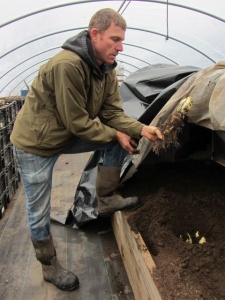What’s not to love about the unmistakable, vibrantly herbal blast of lovage? It’s as if a posh designer got hold of celery and added psychedelic green flowers to the scent, and thinned out the stalks into slender hollow tubes, coiffed by fringed leaves. Growing perennially over six feet high in the garden, and in unimproved clay-dense soil in the shade yet, it’s one of the first plants up in the spring and a Willamette Valley gardener’s dream. It can easily get out of hand once established, so you’ll have to plan well and use the leaves and stalks in many culinary preparations. The tender shoots that emerge in the spring are particularly good, and lack the bitterness of the older leaves.
Lovage, with its aggressive parsley, celery seed, and lemon zest notes, marries well with egg, lemon, cucumber, potatoes, chicken, and beef. Although it’s been a garden favorite for several thousands of years and considered an aphrodisiac, it was much more of a staple for the Romans who used the seeds and dried leaves, and the kitchen staff of Holy Roman Emperor Charlemagne, who were directed to plant it in all his gardens. Indeed, its dramatic stage presence and tendency to bulldoze other flavors in a recipe has frightened off the timid.
Read more about the ancient connections and do sample my own recipes for Roman stuffed eggs influenced by Apicius, or a potato salad with lovage and pine nuts. You might also try a beef stroganoff with lovage, sunchokes and celery, a Romanian meatball and lovage soup called ciorba de perisoare, a mackerel and lovage tart from Hugh Fearnley-Whittingstall for your boldest companions and a petits pois/lettuce/lovage soup for the others, or even lovage in a Scottish breakfast sandwich described by vegetarian culinarian Deborah Madison in her homage to the herb.
As pictured above, one can serve hollow lovage stalks as a straw in any suitable drink, even water, topped with a jaunty leaf hat. It makes for a refreshing afternoon delight after weeding your back 40.
Or you might just enjoy lovage in a cocktail, a spicy Bloody Mary of epic proportions from my colleague and co-host on Food for Thought on KLCC, Ryan Stotz. It’s a perfect drink for Easter brunch, surely a hell of a lot better than nasty jelly beans and low-quality chocolate hollow eggs made tinny by foil. You might try it with a rabbit porcetta and salad of wild arugula and little Western bittercress with roasted beet. Or just a liquid lunch? In any case, if you’re as much of a fan of Ryan’s as I am, you’ll immediately recognize his almost freakishly honed wine professional nose and palate at work here, like a little devious bunny rabbit. And don’t fret too much about the ingredient list — even Ryan admits it can be flexible with what you’ve got on hand. But do try the original when you’re feeling the need for an extravagant and special sunny March morning with your own fine self.
Happy Easter!
Ryan’s Resurrection
Makes one pint.
In a metal tumbler, aggressively muddle the following into a coarse paste. This will take fucking forever and ruin your muddling hand for the day:
- 1 tablespoon black peppercorns (it’s worth getting Penzey’s Whole Special Extra Bold Indian Peppercorns for this)
- 1 tablespoon Sarawak white peppercorns
- 1 healthy dash celery seed
- 1 teaspoon dill seed
- 1 teaspoon salt
- 1 teaspoon sugar
- 2 Piquin chili peppers
- 1/2 teaspoon horseradish powder (again, it’s worth getting Penzey’s for this)
- 3 cloves garlic, peeled
- 1 fresh bay leaf
- 4 or 5 large lovage leaves
- 2″ length lemongrass, finely minced
- Zest of 2 key limes (or just juice the limes, reserve the juice and toss in the peels)
Add the following and stir:
- Juice of 2 key limes
- 2 tablespoons prepared horseradish (at least; I usually add more)
- 1 teaspoon tomato paste
- 10 dashes Worcestershire sauce
- 5 dashes Red Boat fish sauce (I used and loved Three Crabs brand for years, but seriously, the difference between that and Red Boat is like the difference between Cook’s and vintage Krug)
- 20 dashes Crystal Hot Sauce
- 10 dashes Tabasco regular
- 3 dashes Tabasco habanero sauce
- 5 dashes Bittermens or Scrappy’s celery bitters
- 2 tablespoons home-fermented pepper sauce (Culinaria Eugenius’ recipe) or Korean red pepper paste (ssamjang)
- 1 teaspoon Pickapeppa sauce
- 1 teaspoon Datu Puti spiced vinegar
Add ice, the following, and shake:
- 3 oz. Tabasco Spicy Bloody Mary mix
- 3 oz. Spicy V8 or Spicy Clamato
- 3 oz. vodka (who cares what brand, it’s vodka)
Strain into an ice-filled pint glass. Sprinkle on some celery salt,
add a couple dashes more celery bitters, garnish the ever-loving shit
out of it, and drink.
(Recipe courtesy of Ryan Stotz.)








































You must be logged in to post a comment.